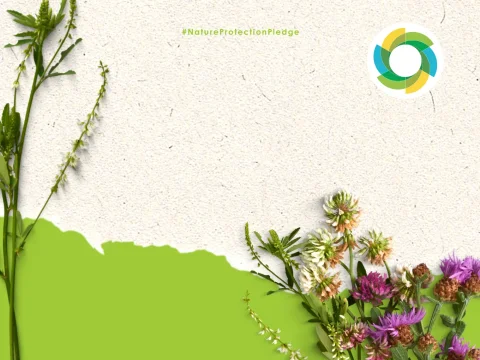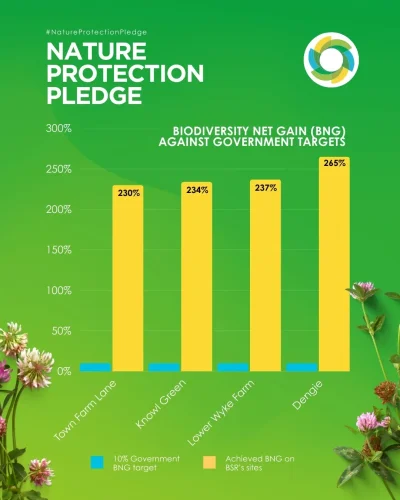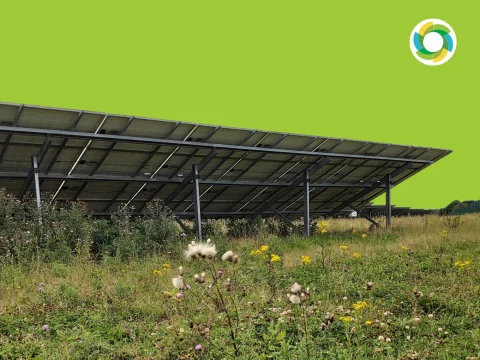
The basics of Biodiversity Net Gain (BNG) on solar parks
The basics of Biodiversity Net Gain (BNG) on solar parks
Biodiversity is at the heart of how we develop and operate our solar parks. From setting ambitious Biodiversity Net Gain (BNG) targets to launching our industry-first Nature Protection Pledge, we’re committed to ensuring that every project gives more back to nature and the land than it takes.
BNG isn’t just a policy requirement - it’s an opportunity. Done well, it can restore habitats, increase pollinators, improve soil health, support food production, and create long-term value for landowners, investors, communities and the climate.
So, what exactly is BNG? What does it mean for energy production, farming and nature? And how can it be achieved? Let’s break it down.
What is BNG?
BNG, or Biodiversity Net Gain, is about making sure new developments leave nature better off than they found it.
In practical terms, it means increasing biodiversity on the site above that which existed pre-development. This is done by creating more, or better-quality, natural habitats than were previously on that site. Under UK law, most developments must now deliver at least a 10% increase in biodiversity. Some examples of that could be planting wildflower meadows, restoring hedgerows, or enhancing ponds or riverbanks for local wildlife to thrive.
At BSR, we go beyond the minimum. Through our Nature Protection Pledge, we commit to tailored, nature-first strategies that support native species and reflect the unique environment of every solar park we develop.
BNG is more than a policy requirement. It’s a practical way to make sure progress and energy production works for people, the planet, and the ecosystems we all rely on.
Is there a minimum for solar developers?
Yes. Under current UK legislation, new solar developments are required to deliver a minimum of 10% BNG.
That’s the legal baseline, but we believe nature deserves more than the minimum. Across our solar projects, we aim for at least 60% BNG, with many sites achieving significantly higher. By designing with nature from the outset, we create spaces that not only generate renewable energy but also support thriving ecosystems for the long term.
How do you achieve BNG?
Biodiversity Net Gain starts with understanding what’s already on the land. Using the government’s Statutory Biodiversity Metric (SBM), we assess existing biodiversity units of which there are 3 types of area habitats, hedgerows, and watercourses to create a biodiversity baseline. From there, we design a plan that improves the site’s ecological value over time.
The calculation is simple:
Habitat units % + Hedgerow units % + River units % = BNG outcome >60%
We achieve this by restoring and enhancing habitats that support local wildlife: planting wildflower meadows, improving soil health, reinstating native hedgerows, and creating wildlife corridors that allow biodiversity to thrive. It’s all part of a joined-up, site-specific approach shaped by our Nature Protection Pledge, which puts nature at the heart of every we do.
This isn’t just about meeting a metric. It’s about creating lasting value - for ecosystems, for rural communities, and for the resilience of the land itself, whilst generating renewable energy.
What is BSR’s Biodiversity Net Gain?
We aim for a minimum target of 60% with every one of our solar projects – with many sites going well beyond. Sites like Town Farm, Knowl Green, Lower Wyke Farm and Dengie are already achieving, or on track to deliver, over 200% BNG, showing what’s possible when you put nature at the centre of design.

Going above and beyond with BNG means richer habitats, more pollinators, healthier soil, and stronger local food production alongside energy production.
These improvements, however, don’t just benefit wildlife. They also create practical value for farmers too. More pollinators can mean better crop yields. Healthier soil can reduce the need for inputs. And by supporting farmers, we help make farming more resilient to the pressures of climate change, disease, and market volatility.

